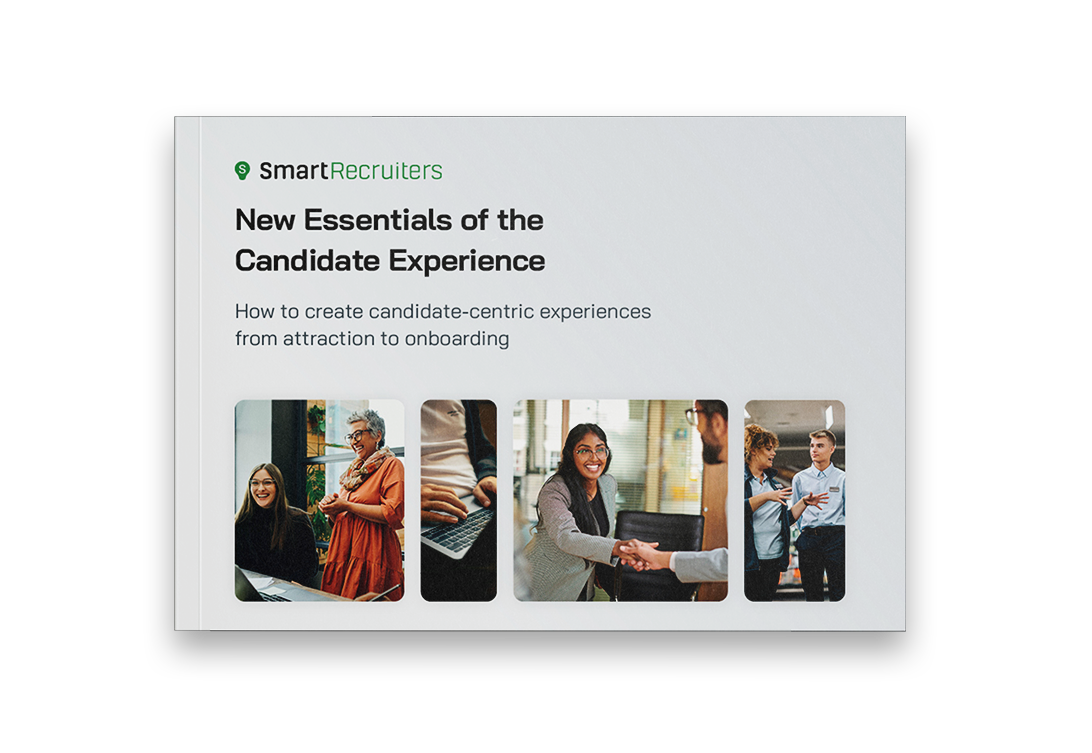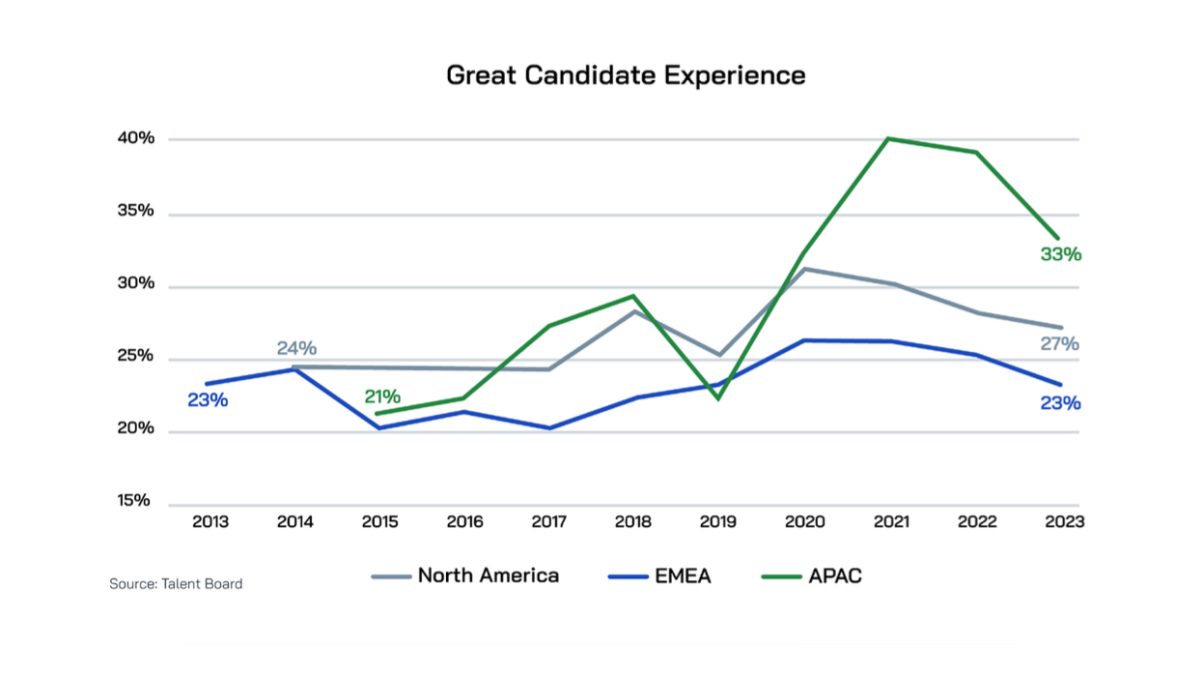We live in an experience-driven world. Companies spend significant time and resources to improve the customer experience, employee experience, and product user experience. In recruiting, it’s all about the candidate experience.
As the front door to a deep relationship with your organization, improving the candidate’s experience is an ongoing challenge in the face of evolving candidate expectations and recruitment technology.
Just what does the data tell us about why we need to keep our focus on a stellar candidate experience? We gathered these recent statistics in the ebook New Essentials of the Candidate Experience: How to Create Candidate-Centric Experiences from Attraction to Onboarding to illuminate current trends.

Recruiting statistics on why the candidate experience matters
In today’s talent shortage, employers need to do more than ever before to find the right talent–and keep them engaged through the hiring process once they find them.
- 77% of employers globally report difficulty finding the skilled talent they need, versus 35% a decade earlier.
- 72% of candidates say the smoothness of an interview process would affect their final decision on whether or not to take the job.
People have become accustomed to positive experiences–in user design, in customer service–the list goes on. Companies are investing more in talent attraction and employer branding to address the competition for talent. In short, the game has changed. Candidates want a peek inside your company–and they want to know that it has a mission that excites them.
- 64% of global talent professionals predict that the future of recruiting will be more favorable to candidates and employees (as opposed to employers) over the next five years.
- 60% of the same group of talent leaders say their company will invest more in employer branding.
- 77% of global workers feel a company’s values and purpose (including sustainability, diversity, and transparency) are important when selecting an employer.
Delivering on the promise of employer branding
Investing in employer branding is only worthwhile if your company can deliver on the experience depicted in the branding materials. Somehow, this message isn’t always getting across, according to the Talent Board, which surveys more than 200,000 candidates each year.

- More than two-thirds of candidates see an opportunity for a better experience when they apply to roles.
- Candidates who have negative experiences are 185% less likely to be willing to refer other job seekers to your company.
- The chart above shows that the percentage of candidates reporting a poor experience has grown in North America over the last decade, from 10% in 2013 to 12% in 2023. While it may seem like a small percentage, it represents millions of people who gain a negative impression of company brands.
A better application experience improves recruiting outcomes
The application experience, which should be simple and seamless, is the first place where slick employer branding can fall apart. Login requirements, clunky forms, and difficultly completing the application on mobile are surprisingly common.
- Research shows that the candidate drop-off rate for people who click “Apply” but never complete an application is a whopping 92%.
- 34% of candidates in 2022 reported not hearing back from employers two months after they applied.
- Only 58% of candidates say they received an automated “thank you” message after completing an application.
Improving the application experience is a powerful way to attract more talent. With SmartReecruiters, KinCare reduced its time to complete applications to 3-5 minutes from 17 minutes.
- For KinCare, a streamlined application process resulted in a 60% decrease in candidate drop-off and helped bring in higher-quality candidates.
A better interview experience nets better hires
Difficulty scheduling interviews, long wait times between interviews, and unprepared interviewers are just a few of the problems candidates encounter. Guess what? They don’t like it–and they could accept another offer before your hiring manager decides to move a candidate forward.
- According to the Talent Board, two of the top three reasons candidates around the world withdraw from the process are “My time was disrespected during the interview process” and “The recruiting process took too long.”
- 54% of candidates have abandoned a recruitment process due to poor communication from the recruiter/employer.
- 62% of candidates would prefer an automated system that manages the interview process efficiently rather than lengthy back-and-forth communication.
Structuring the hiring process is proven to helps companies hire candidates who are more likely to become long-term employees.
- After revamping their overall hiring process and implementing structured interviews, Colliers EMEA reported a 25% increase in first-year new hire retention.
- Automated hiring workflows for 30 different role types and improved hiring team collaboration contributed to a 30% improvement in six-month new hire retention at Catholic Healthcare.
Structured onboarding fuels retention
A well-organized onboarding process contributes to positive employee engagement – and can contribute to long-term employment. Surprisingly, a significant portion of companies do not have a system to manage onboarding.
- 77% of new hires with high onboarding satisfaction said they could see themselves having a long career at their organization, compared to just 29% of those with low onboarding satisfaction.
- 42% of companies do not have a dedicated onboarding solution.
Where the employee experience meets the candidate experience
In a talent shortage, filling roles internally becomes increasingly important. A strategy to facilitate internal mobility and increase referrals is a powerful way to improve retention and strengthen the employer brand.
- 75% of recruiting pros say internal recruiting will be an important factor shaping talent acquisition over the next five years.
- Employees at companies with high internal mobility stay 60% longer.
- Just 25% of companies are confident with their internal mobility strategies.
- 77% of companies have lost talent due to the lack of career development opportunities.
It doesn’t take long to make an impact with internal mobility and referrals.
- Three months after CityFibre implemented the SmartRecruiters Employee Portal, more than one in five hires (21%) came from employees, and nearly as many (19%) came from referrals. In addition, more than 10% of employees signed up for job alerts.
Measuring the candidate experience helps you improve it
It should be no surprise that when you treat people well, they’re more willing to say something nice about you–even if they didn’t get the job they wanted. When companies collect candidate feedback, they’re participating in a cycle of goodwill by asking how they can do better.
- Candidates applying to companies with the highest candidate experience ratings have nearly a 20% higher willingness to refer rating than companies with an average or poor candidate experience.
- Candidates who were invited to provide feedback after the interview were 65% more likely to refer others.
Candidate surveys are the most common approach to capturing feedback.
- The average response rate to candidate surveys is 28%. Those who are hired have the highest response rate, at 54%.
- 20% of companies survey candidates at every stage.
The next step: Improve the candidate experience
Statistics by themselves do nothing except point to the changes you need to make. If you’re having to decide which changes to make and how to make those changes, we wrote an ebook that can help. It’s called New Essentials of the Candidate Experience: How to Create Candidate-Centric Experiences from Attraction to Onboarding.
Get started by downloading it today.







